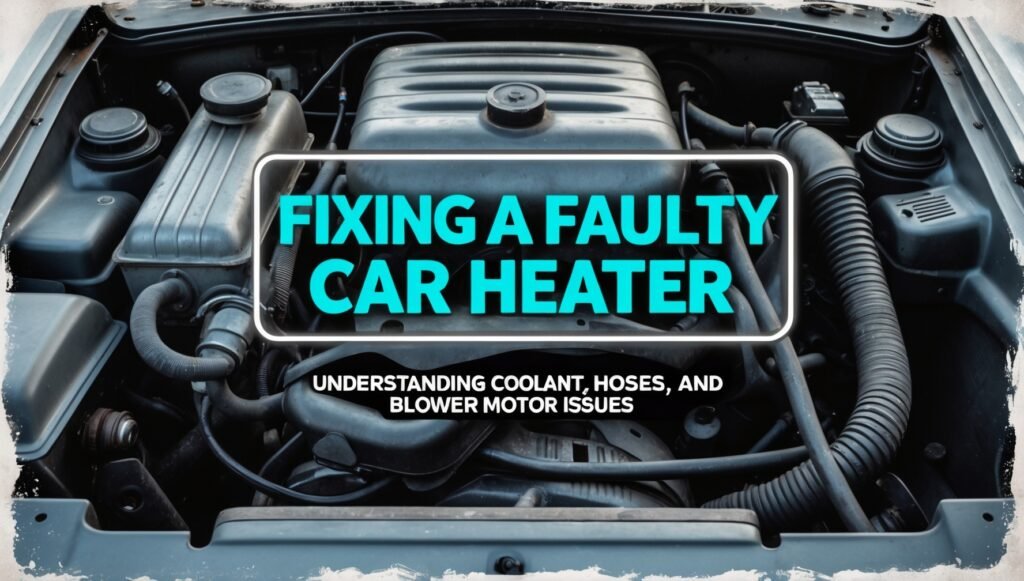
A faulty car heater can make winter driving unbearable. If you’ve ever turned on your heater only to be greeted with cold air, you know how frustrating this issue can be. Fortunately, diagnosing and fixing a malfunctioning car heater doesn’t have to be a daunting task. With the right approach, you can solve the issue and get your heater working again—without paying for expensive repairs.
In this blog, we’ll explore the common causes of car heater problems, including coolant issues, clogged hoses, and blower motor failures. We’ll guide you step-by-step on how to diagnose these problems and fix them yourself, saving you time and money.
Step 1: Understanding How the Car Heater Works
Before diving into repairs, it’s important to understand how your car’s heating system works. The heater relies on the engine’s coolant, which absorbs heat as it circulates through the engine. The heated coolant flows into the heater core, which acts like a small radiator. Air is blown over the heater core and into the cabin, warming up the car.

Here’s a breakdown of key components:
Heater Core: Transfers heat from the engine coolant to the air blowing into the cabin.
Blower Motor: Circulates air through the heater core and into the cabin.
Coolant: Fluid that absorbs heat from the engine and transfers it to the heater core.
If any of these components are faulty, it can lead to a malfunctioning heater.
Step 2: Diagnosing Coolant Issues
If your heater isn’t blowing warm air, the first thing to check is the coolant level. Low coolant levels can cause the heater to blow cold air, as there won’t be enough fluid circulating through the system to provide heat.
How to Check and Refill Coolant:
Allow the engine to cool down: Never open the radiator cap when the engine is hot, as the coolant can be under pressure and could burn you.
Locate the coolant reservoir: The coolant reservoir is usually a translucent tank near the radiator.
Check the coolant level: If the coolant is below the minimum line, it’s time to top it up.
Add the coolant: Use the manufacturer-recommended coolant for your vehicle and top it until it reaches the “max” line.
If your coolant level is fine, the next step is to check for leaks or blockages in the system.
For a coolant refill kit, you can find an excellent option on Amazon, designed for quick and easy coolant top-offs.

Step 3: Checking the Heater Hoses for Blockages
Heater hoses carry coolant to and from the heater core. Over time, these hoses can become clogged or damaged, preventing coolant from flowing properly through the heater core.
How to Inspect and Replace Heater Hoses:
Locate the heater hoses: These hoses are typically near the engine bay, leading to the heater core.
Inspect the hoses: Look for signs of cracks, leaks, or blockages. If the hoses are clogged or leaking, they need to be replaced.
Test the flow: With the engine running and the heater on, feel the hoses. They should be warm to the touch. A blocked hose or clogged heater core might cause one hose to be cold.
Replace the hoses: If the hoses are damaged or clogged, replace them with new ones. You can find replacement hoses at your local auto parts store or online.

For replacement heater hoses, check out this option on Amazon. This product is compatible with most vehicles and perfect for DIY repairs.
Step 4: Inspecting the Blower Motor
If the heater is blowing air but it’s not warm, the issue could lie with the blower motor. The blower motor circulates air through the heater core and into the cabin. If it’s malfunctioning, it may not be blowing air at all, or the airflow may be weak.
How to Test and Replace the Blower Motor:
Turn on the car and the heater: Set the fan speed to high and listen for the blower motor. If you don’t hear any noise or feel any air, the blower motor may be faulty.
Check the fuse: A blown fuse can prevent the blower motor from operating. Check the fuse box and replace any blown fuses.
Inspect the blower motor: If the fuse is fine, but the blower motor still isn’t working, it’s likely the motor itself is defective.
Replace the blower motor: To replace the blower motor, you’ll need to remove the dashboard panels that cover the motor, then remove the motor itself and install the new one.

For a high-quality blower motor replacement, check out this motor available on Amazon. It’s easy to install and compatible with a variety of vehicle models.
Step 5: Test the Heater System
Once you’ve checked the coolant, hoses, and blower motor, it’s time to test the heater system:
Start the engine and let it warm up for a few minutes.
Turn the heater on: Set it to the highest temperature and fan speed.
Check for warm air: The air coming from the vents should be warm. If the air is still cold, there may be an issue with the heater core itself or a more complex electrical problem.
Finally
A faulty car heater can be an annoying problem, especially during the winter months. However, by understanding the common causes—coolant issues, clogged hoses, and blower motor failure—you can diagnose and fix the problem yourself. With the right tools and a little know-how, you can avoid the high cost of professional repairs and keep your car’s heating system working smoothly.
Regular maintenance, such as checking the coolant level and inspecting the hoses and blower motor, can also help prevent future heater issues. If you continue to experience problems, consider consulting a professional mechanic for a more thorough inspection.
FixItSmartly.com helps everyday people save money and build confidence by tackling home and car repairs with easy, practical DIY solutions. Live smart, safe, and self-reliant — one fix at a time.
Copyright © 2025 Fixitsmartly